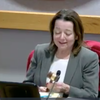Federal grant to help Karner blue
By next year, the endangered Karner blue butterfly will have more places to subsist.
The Albany Pine Bush Preserve Commission has been awarded a $143,289 grant, from the federal Fish and Wildlife Service. The funds will be used "for habitat restoration and the preservation of private land, specifically to promote and expand the habitat for the Karner blue butterfly," said Christopher Hawver, the commission’s executive director.
The Karner blue butterfly is listed by the federal government as an endangered species. A viable population of the Karner blue is 3,000, scientists say. In 2004, there were barely 1,000 in the entire Pine Bush, down from 65,000 in 1980, and millions in the 1940s.
The Karner blue eats the blue lupine, a perennial in the pea family. The survival of the Karner blue is directly linked to the lupine. Lupine plants thrive in sunlight and open meadowy fields, and, with more and more area development, lupine land is destroyed.
For the past few years, the preserve commission, an inter-municipal agency, has been aggressively working toward conserving the Pine Bush, a rare inland pine barren. With the help of the states Department of Environmental Conservation, the federal Fish and Wildlife Service, and two private not-for-profit organizations the Wilton Wildlife Preservation Park and The Nature Conservancy 200 acres have so far been restored, Hawver said.
"It’s a big partnership between all of us. We all work together on this," he told The Enterprise. "It’s a joint effort that we’ve been working hard on for a long time."
With the latest grant, trees, like the black locust, will be removed from 30 acres of land, he said. The black locust is a non-native, invasive tree that pushes out native plants that the Karner blue needs to survive, he said.
Then, native plants, grasses, and shrubs will be added to the area, Hawver said.
"It’s going to be more like an open prairie, like in the Midwest," Hawver said.
He expects the latest project to happen off of Kings Road, near the border between the towns of Colonie and Guilderland. Work will most likely begin next year, he said.
"Thirty contiguous acres is really significant," Hawver said. "We’re thrilled. Without the help from the grant, in no way would we be able to do what we do."
The work, he said, "is expensive but worthwhile." For example, it costs $4,800 to remove black locusts from one acre, he said.
"It really works," Hawver said. "We can see there are actual changes in the area where there were no butterflies before."


